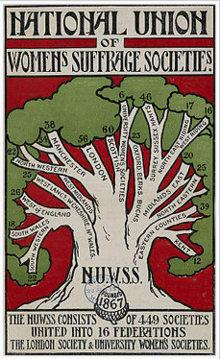Florence Annie Conybeare
Florence Annie Conybeare (13 September 1872 – 29 February 1916) was a British campaigner for the
Birth
Conybeare was born Florence Annie Strauss on 13 September 1872 in
, a town known for glass production, who became a naturalised British subject. Her mother, Frances Lehmaier, was born in New York.Marriage
On 15 October 1896 she married the 43-year-old bachelor, former Liberal MP for Camborne, Cornwall, and practising barrister,
The Conybeares lived in
Women's suffrage
1907: Women's Enfranchisement Bill

Conybeare was an active organiser, supporter and voice within the Women's Suffrage movement.[citation needed] She had supported Mr. W.H. Dickenson's[note 2] bill which received its first reading on 8 March 1907. Up to then married women living in the same house were not regarded as 'joint owners' of that property by law. The Dickenson Bill proposed that husband and wife living under the same roof should both be considered as 'joint occupiers' of the property which, as a consequence, would give married women equal status with men and the right to vote.
1908: Women's Suffrage: A Liberal Principle
In her ‘treatise’ Some Objections Answered published in 1908,[1] in which she claimed that "Women’s Suffrage is essentially a Liberal principle", Conybeare wrote a reply to an article written by Edith Calkin,[5][6] one of the women critics of Women's Suffrage. She rebuked Calkin for wanting to deny women political recognition and argued why women should be given the right to vote, and aired her objections to Edith Calkin's approach to women's rights.
The inequities of legislation
- Conybeare referred to Mr Dickenson's 'Women's Suffrage Bill of 1907' [ed. Women’s Enfranchisement Bill], which, if passed, would treat married women as 'joint occupier' of a dwelling, and chided Calkin for ignoring recent legislative developments concerning Women's Suffrage.
- Conybeare believed that all women should be eligible to vote, irrespective of any 'property qualification'.
- It was not right that women who paid rates and taxes had no right to decide how money is spent; taxation and representation belonged together.
- The Married Woman’s Property Act of 1882, she wrote, was "very unsatisfactory for women", especially given the fact that married woman typically ran 16-hour days multitasking for their husbands, and any savings a woman made while running a home were the property of her husband.
- The Law of Divorce "treated men and women differently, making it far easier for a husband to divorce his wife than for a wife to rid herself of a bad husband".
- She objected to married women being barred from voting in municipal elections.
- Women should be allowed to vote so they can help run the country, and pointed to the "very active part" women have played in the country's political life, and said that the last General Election [ed. 1906] "had been fought as much by men as women", thanks to the Women's Liberal Associations and the Primrose League, whose work had been used by all the political parties.
The plight of working women
- Conybeare rebukes Calkin's claim that women's place is in the home, and for failing to address the issue of women's pay.
- Conybeare defined 'sweated labour' as "a woman who is paid less than a man for the same work".
- While highlighting the drudgery of working women, Conybeare asserted that "women of leisure have a duty to fight for the rights of the working woman".
- She urged working women to unite and lobby for Women's Suffrage because it was not only for their own good, but also because it would "raise the status of working women", especially as "the status of the poorest class of male worker had vastly improved" once he had been granted the right to vote in 1884".
1913: Suffragist meeting at Dartford
On 24 July 1913, a meeting of the
Speech: Australian vs. British suffragism
Matters, who had been sentenced to a month in
At the end of the speech, Conybeare invited Councillor W.H.D. King to give the vote of thanks. He said that he felt ashamed that he had the vote while they did not, but thanked the party for recognising Dartford as a place of importance worth visiting.
Civic work
Conybeare worked in Voluntary Aid Detachment at Charing Cross Hospital, London.[8]
She raised money in Dartford during the First World War for an ambulance.[9]
She was president of the Dartford Women's Liberal Association, and had largely been responsible for the setting up and running of the Babies Club.[8]
Death

Conybeare died at her father's home in Kensington, London, on 29 February 1916, aged 43, after 18 months of failing health, while her husband, Charles Conybeare, was at Canterbury.[8][10]
Endnotes
References
- ^ a b Women's Suffrage: Some Objections Answered, an article written by Florence A.V. Conybeare, in The Commonwealth & Empire Review, 1908, pp 282-287.
- ^ Birth certificate, 23 October 1872, General Register Office, Southport, England.
- ^ a b Pottery Gazette, 1 August 1890. Apparatus for producing glass tube for use in making large beads, Patent No. 49,659, Class XXXIII; refers to birthplace of inventor
- ^ Marriage certificate, 15 October 1896, General Register Office, Southport, England.
- ^ Edith Calkin's article "Votes for Women", published in The Commonwealth and Empire Review
- ^ The Commonwealth and Empire Review Archived 8 December 2015 at the Wayback Machine Vol. XIV, Sep. 1908.
- ^ Adapted from The Calm Before the Storm: Dartford 1900-1914, by Dr Mike Still, Curator of the Dartford Borough Museum, 2014, based on a newspaper article in the Dartford Chronicle & District Times, 1 August 1913.
- ^ a b c Obituary in the Dartford Chronicle, March 1916.
- ^ Dartford and The Great War, Gethyn Rees, 1998, p. 18.
- ^ Death certificate, 29 February 1916, General Register Office, Southport, England.
